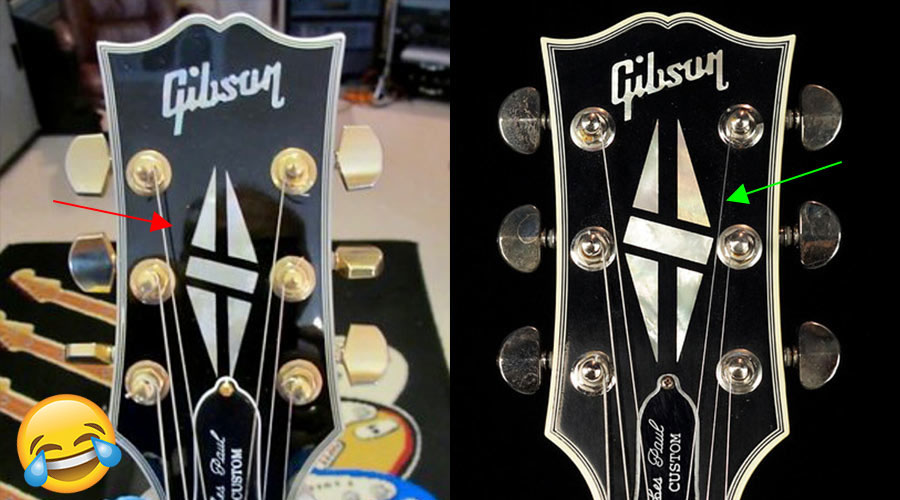
You’ve been scanning Reverb for months looking for your dream Les Paul and then one day you see it. It’s a Gibson Les Paul, 50’s spec, Cherry Sunburst, and it’s only 500 bucks.
“What! I’m having that!” So, without hesitation, you pony up. Delighted with your eye for a bargain, you eagerly await the arrival of your guitar. Finally, you get it and what a sight to behold, it is gorgeous. You plug it in and wow, it sounds great.
The thing is, once the dust settles you start to notice some things. It is just off, and you cannot quite put your finger on it. The sound is not as good as you first thought, and there are lots of little flaws that you seem to be multiplying each time you play it. Then you take it for a jam with your buddy and you can see it as clear as day, next to his Les Paul it looks cheap, and it sounds bad. It is fake, a counterfeit, a Chibson.
Only Fools Rush In…
They say a fool and his money are soon parted, and let’s face it, we are all fools for a nice guitar. But, what happens when the deal is almost too good to be true? Well, the simple answer is, if it is too good to be true, it is. End of.
The purpose of this article is to give the uninitiated a few of the tell-tale signs that give away a counterfeit Gibson. Now, I must caveat this by saying not all fakes will have all of these. The quality of fake goods never stands still, some are better than others and some may only have one or two of these issues. There are no hard and fast rules. If you only take one thing away from this article then please let it be this: USE YOUR COMMON SENSE. If the guitar is considerably cheaper than similar models, chances are it is fake. It is an 80’s cliché, but money talks. If anything seems fishy in any way, just walk away. Gibson has been producing Les Paul Model guitars since 1952, there is no shortage of them available to buy. Just be patient and you will get the real thing sooner or later.
Now on to the good stuff.
Body Shape
The first thing to look out for is the body shape. What does the lower bout look like? Does it seem a bit wide? What about the cutaway?
This is something that the knockoff guitar manufacturers seem to struggle with, and it can be a really easy way to spot a fake. A genuine Les Paul will have a rounded horn and the cutaway will follow the contour of the body. If the horn is sharp or the cutaway exaggerated, then it is most likely a counterfeit.
Cross-check pictures of the lower bout with a real one. Sometimes the fakes can be a bit wider, almost bulbous.
Now, in recent years some of the counterfeiters have improved and it is worth noting that even Norlin-era Gibsons have a slightly sharper horn shape than the classic design, so this is by no means foolproof but is definitely worth looking out for. The aim here is to create a checklist of things to use that can verify the instrument’s authenticity, so this can be a very quick warning sign.
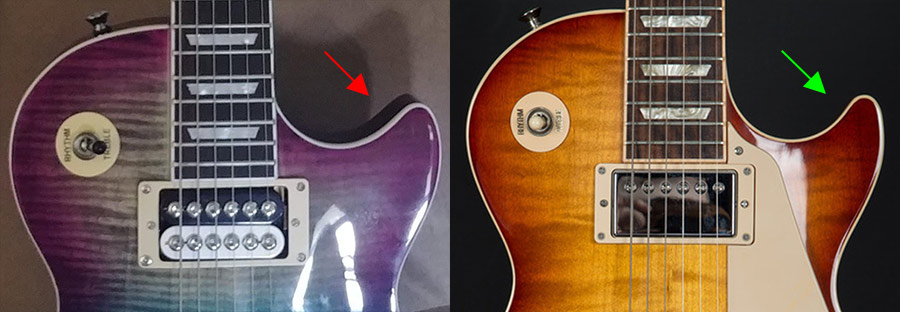
Counterfeit Les Paul cutaway on left vs genuine on right. Also, notice the domed screws and thicker pickup rings on the fake.
Tailpiece
This is another easy one to check, yet the counterfeiters still seem to have a hard time with it.
The tailpiece on a genuine Gibson Les Paul will be slightly higher than the adjacent volume knob, and a counterfeit will often be lower than the volume knob. Another way of looking at this is that the distance between the bridge and the tailpiece will be exaggerated on a fake.

Notice how the volume knob is above the tailpiece on the fake Les Paul.
Headstock
The way that Gibson produces the famous, open-book head stock is a little quirky.
The neck and headstock are created from a single, roughly cut piece of mahogany. The headstock will measure about the same across as the neck does, so the typical 1.695 inches. Then Gibson will add two pieces to the sides of the headstock, these are called wings. If you look at the back of a lighter finished guitar you can usually see the seams of the two added wings.
The counterfeit guitars don’t do this, and the headstock will be made from a single piece of wood.
A Gibson guitar will always have a three-piece headstock.
Also check the shape of the headstock, this will often be unsymmetrical or just look a bit off particularly the center of what would be the spine of the book.
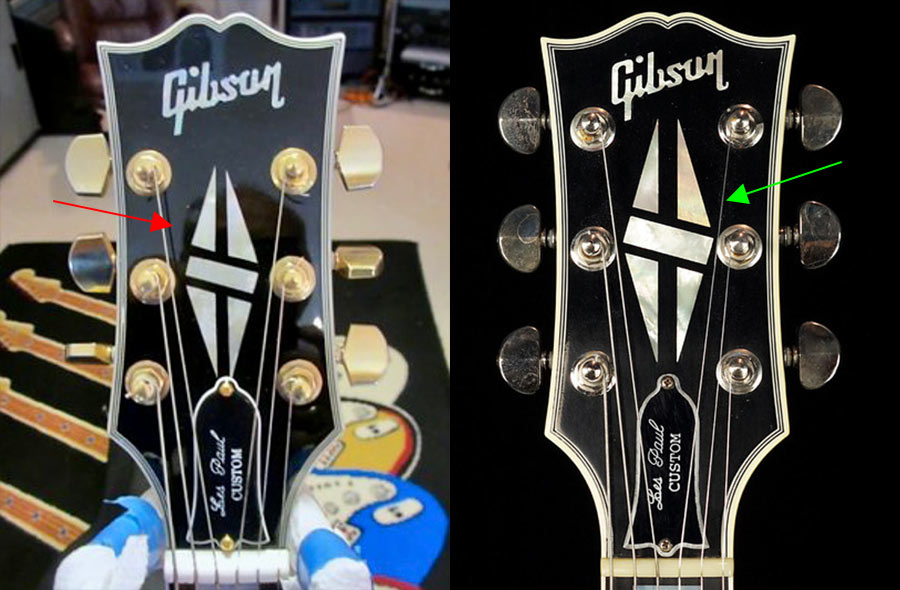
Fake headstock on left and real one on the right. Notice the difference with the shape of the top of the headstock, and the size of the diamond inlay.
Truss Rod
The fake one will usually be an Epiphone style, Allen wrench adjustable rod instead of the Gibson, nut adjustable rod. Behind the Gibson truss rod cover should be, but not always, clean while the fake will often be a bit messy.

Truss Rod Cover
This one is an absolute classic tell on a fake. Now, you would think that with all the trouble these people go through, to build a fake guitar that the little plastic truss rod cover would be easy. Well, apparently not!
Firstly, a Gibson Les Paul will only ever have 2 screws, top and bottom. Because these fake Gibsons are mostly manufactured in China, they often use “import” type parts. These will be similar to Epiphone parts, they can have two screws at the bottom and one at the top, and they will be flimsy, single-ply plastics. Oftentimes the alignment will be poor. The 3-screw covers are becoming less common, but even the 2-screw variety is poor quality.
Please bear in mind that these things can be swapped for genuine parts, but it is still worth the time to check.
If in doubt, compare it to a genuine guitar. The difference will be obvious.
Electronics
A fake guitar manufacturer’s sole aim when building this guitar is profit. That means that the absolute cheapest components that they can get away with using will be on the instrument. One of the ways they can cut corners is with cheap electronics.
Have a look in the control cavity on the back of the guitar. Does it look clean? Is there a lot of sawdust? Is the paint job rough inside, is there even any paint at all? How does the wiring look, is it nicely ordered with clean soldering, or does it look like spaghetti? Is there a white plastic connector inside?
A Gibson Les Paul should have a nice clean route, clean solder joints, and well-organized wiring. Some Gibsons will have push/pull connectors and printed circuit boards (PCB). Some will have a metal plate that the pots are attached to, and the Custom shop reissues will just be 4 pots, a jack, a ground wire, and an extremely neat wiring job.
A fake guitar is very likely to have cheap, import-type electronics that are poorly installed. I have even seen ground wires attached to the body via a screw. The routing can often be rough. The wiring harness might have a white connector and will almost certainly have non-branded pots.
Gibson guitars will always either have Gibson-branded pots or CTS pots.
Check the selector switch, a Gibson Les Paul will always have a Switchcraft selector switch.
This will be attached on the outside of the guitar with a circular splined nut. A fake can often be attached with a hex nut and may have an oversized switch tip.
Again, I must stress, these parts can all be changed so please be cautious.
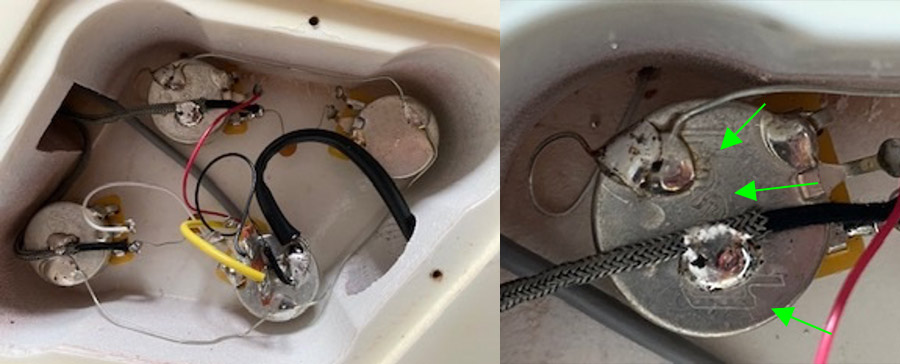
Screws
This one is my personal favorite; I almost don’t want to give it away in case a counterfeiter is reading this.
If the guitar has black pickup rings, on a white Custom for example, the screws on a real Les Paul will always be black. These are the four screws that attach the pickup rings to the body of the guitar, not the adjustable screw in the middle. These will not be GOLD. This is such a minor detail, but they never get it right.
I suspect the reason for this is that Epiphone doesn’t color-match the screws, but nevertheless it is incorrect for a Gibson guitar.
The screws on a Gibson will also be flat-headed. Many times a counterfeit will have dome-headed screws. Again, a small detail but worth looking out for.
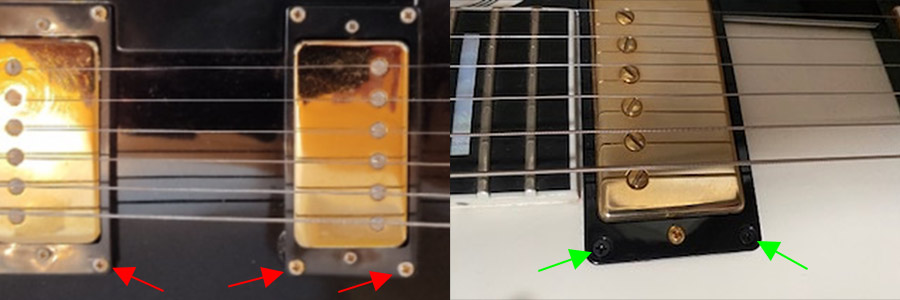
Hardware
A real Gibson Les Paul will normally have either a Nashville type bridge or an ABR-1. A Nashville is a chunkier model, that is attached to the top of the guitar via studs and a dome screw. The ABR-1 is the more traditional, slimmer bridge that is screwed directly into the wood. Both bridges are adjustable using thumb wheels.
The type of bridge on the counterfeit instrument is like that of an Epiphone and is almost a cross between a Nashville and an ABR-1, in that it has the general appearance of the ABR-1 but it is chunkier and it attaches via studs.
This “import” style bridge will have slotted screws to adjust the bridge height, and the studs that the bridge attaches to the body are thicker than the Gibson equivalent.
A Gibson Les Paul will NEVER have a bridge that you can adjust with slotted screws.
Fret Nibs
If you have traded up from an Epiphone to a Gibson, one of the first things you will have noticed is the fret nibs, or the lack of them on the Epi.
One of the things Gibson does that other manufacturers don’t is add nibs to the end of the frets. This is effectively the continuation of the fretboard binding up to the edge of the fret. Now some people love it, and others hate it, but there is no doubt this adds an extra layer of complexity and cost to the final product.
In the early days of the knock-off Les Paul the manufacturer simply forgot about these nibs, and the fret would come to the edge of the fretboard, just like an Epiphone Les Paul. These ones are easy to spot since a new Gibson will always have fret nibs.
The newer version 2.0 Chibsons are now more likely to have nibs, but they are typically poor in terms of workmanship. Things to look out for are poorly aligned nibs to the fret gaps between the fret and the nibs, and excessive tooling marks.
It would be remiss of me not to mention Gibson’s own quality control at this point. Without question, Gibson has been guilty of letting some poor workmanship escape the factory over the years, and one of the areas where they have been criticized is the fret nibs. So, even with a real Gibson, it is possible to see some tooling marks or even a slight gap between fret and nib, but I really must stress this is the exception, not the rule.

Miscellaneous
Check the inlays on your guitar. A Gibson will always be fitted parallel with the direction of the fret in a straight line. It will be neatly pressed into the fretboard with all excess glue removed.
On a fake Gibson, the inlays can often be crooked or misaligned, and there may be excess glue residue around them.
Check the serial number on the back. A genuine Gibson will have had the serial number and “Made in USA” pressed into the back of the headstock.
The counterfeit guitar will have had the serial number engraved into the back instead of pressed. The result is the number is too deep into the wood and the font usually appears off.
Another thing to note here is that the serial numbers will most likely be genuine serial numbers that they have “taken” from a real Gibson guitar. If this is the case, a search on Guitar Dater Project, or even a call to Gibson customer service will show the guitar as being genuine.
Check the tuner alignment. They should be in a neat row of 3 per side, and they should not be crooked. While it has been known for Gibson to get this wrong, it is still a worthwhile exercise.
Have a good look at the Gibson logo. The counterfeiters have a habit of over italicizing the logo. The lines of the G, B and N should be straight relative to the edge of the neck/fingerboard, not at an angle.
Have a look at where the binding on the body meets the fretboard in the cutaway. Is there a gap? If there is, then it is most likely a fake. A real Les Paul will have the body binding meet the fretboard binding perfectly, with no visible gap.
Lastly, have a look at the alignment of the Volume and Tone Controls. On the real thing, the 2 volume controls will be in a straight line relative to each other and likewise with the tone controls.

Final Thoughts on Spotting Fake Gibson Les Pauls
There you have it how to spot a fake Les Paul. It is important to stress that the market in fake guitars is worth a fortune, and as such, it pays for the people forging them to constantly evolve and improve. These are just some of the things that can single out the counterfeit but with time they will get more and more difficult to spot.
This is not a comprehensive list, and you are unlikely to find a guitar with all the tell-tale signs, but if you notice just one or two, then be wary. If in doubt, walk away.
If you are looking for a Gibson Les Paul, my advice to you is to buy it from a reputable dealer. If you cannot afford the money to buy new, or dealer prices for secondhand, then get to know the Les Paul. Go and play them at your local music store, even if you can’t buy the ones in the showroom. Try them out, look at pictures of them online, and make sure you are not going into it blind.
Lastly, and above all else, use your common sense. If it looks too good to be true, it is. It really is that simple. In these days of the internet, nobody is going to give away a high-value item like a Gibson guitar for peanuts.
Happy hunting!
Share your thoughts in our forum! 💬
👉 Introduce yourself and show off your Les Paul and other gear.
Frequently Asked Questions
How can you tell a Chinese Les Paul?
Wrong body shape, cheap hardware, poorly aligned tailpiece and volume/tone controls, one piece headstock instead of the correct three piece. These are just some of the easiest ways to tell.
Do fake Gibsons have serial numbers?
Unfortunately, they do and what’s worse is they are usually “stolen” from genuine guitars. So do not let a serial number fool you.
Where is the serial number on a Gibson Les Paul?
The serial number for a Gibson Les Paul is always on the back of the headstock, and it will always be pressed into the wood, not etched, routed or engraved.
Share this post with your friends using these one-click sharing options:
👉 Click here to share on Facebook.
👉 Click here to share on Twitter.
👉 Click here to share on LinkedIn.
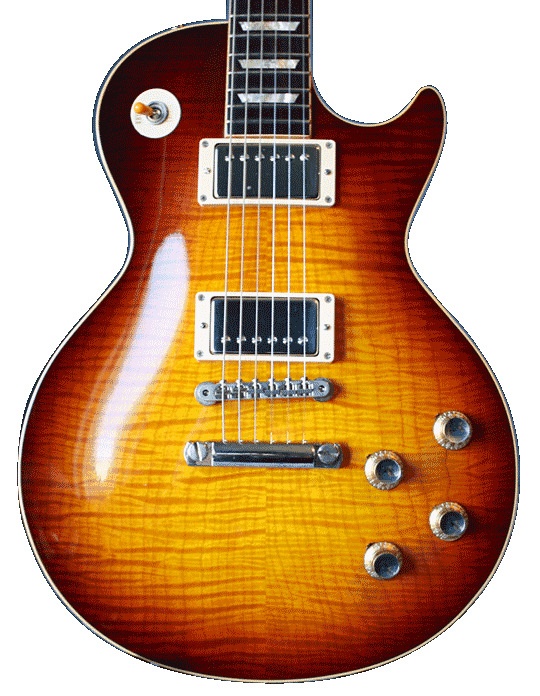
Get the latest reviews, guides and videos in your inbox.